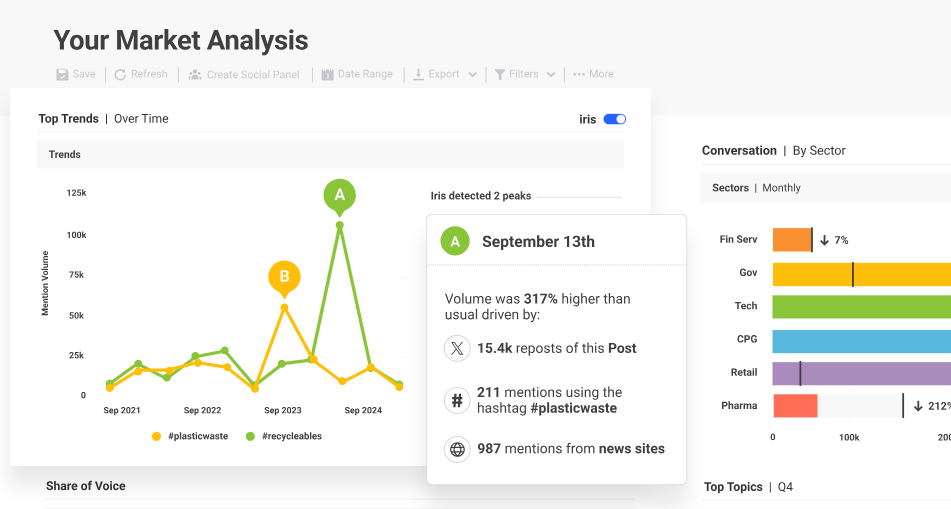
Social listening is your way of tuning into the digital chatter. It helps you get to know your audience, understand their needs, and identify trends that could skyrocket your brand’s success. But how exactly does it work? And why should it be a crucial part of your digital marketing strategy in 2025? Let's break it down.
If you’ve ever scrolled through your feed, explored videos under a trending sound, or checked out a hashtag, you’ve already participated in social listening.
Social listening involves tracking and analyzing online conversations to identify trends, sentiments, and customer feedback that can guide your strategy. It's not just about hearing what people say, but actively listening and understanding it.
Understanding your audience’s sentiments—whether they love or hate your product—helps you refine your approach. This insight ensures your content hits the right note, avoids potential PR disasters, and makes your messaging more relatable.
Set up social listening tools like Hootsuite, Brandwatch, or Sprout Social to track keywords, hashtags, and brand mentions. This data helps you make smarter decisions about your content, customer service, and marketing.

Social media doesn’t wait for anyone. We all know memes and trends have short lives. So why should your brand react after the wave has passed? Social listening helps you stay ahead of the curve by providing real-time insights that keep you relevant. You can identify trends as they happen, jump on relevant conversations, and create content that feels fresh and timely.
By catching trends early, your brand can be at the forefront of what’s happening, whether it’s a viral meme, news event, or cultural moment. This creates opportunities to engage your audience in ways that feel authentic and relevant.
Track trending hashtags and keywords in real-time. Use social listening to jump on relevant trends (without looking like you're forcing it), create timely content, or even respond to a meme your brand can uniquely riff off of.
Here’s the thing—people are chatting about your brand all over social media. Whether it’s praise, complaints, or simple thoughts, social listening is your chance to tune into this unfiltered feedback. By collecting and analyzing this feedback, brands can make informed decisions about everything from product development to customer service.
By hearing directly from your customers, you can build stronger relationships, resolve pain points, and deliver exactly what they want. Whether it's fixing an issue or amplifying what they're loving, you're actively working to create the best experience for your audience.
Monitor conversations around your brand and industry. Are people complaining about a feature? Complimenting your service? Make sure you're responding appropriately, adjusting products, and recognizing loyal customers.
Let's be real—customers don’t always reach out through traditional channels. And according to Sprout Social, 78% of people expect responses from brands within 24 hours on social media. They might send you a direct message on Instagram or even leave comments on your public posts. Social listening helps brands monitor these interactions, allowing them to resolve issues quickly before they blow up.
By addressing customer concerns in real-time, you show that your brand cares about customer satisfaction and is committed to offering a stellar experience. The faster you respond, the more loyal your customers will become.
Track mentions of your brand and key product/service terms across all platforms. Respond to complaints or questions quickly, offering solutions and showing empathy.
Your customers are the ultimate experts on your products. Social listening allows you to track not only what people love about your brand but also what they want to see improved. This feedback loop can be a goldmine for innovation.
By listening to your audience, you gain actionable feedback that helps improve your offerings. If customers are talking about needing a new product feature, why not listen and add it to your next release?
Monitor discussions around your products or services. Act on feedback—whether it’s improving features, solving issues, or launching new offerings that align with customer desires.
Below is a summary of some of our favorite social listening tools, but check out our blog post, 7 Best Social Listening Tools to Unlock Brand Insights, for a full list with more details.
Social listening is not a one-time effort. It’s an ongoing process that requires you to actively listen, analyze, and respond—but when done right, the results can be game-changing.
So, get listening. Your audience is talking, and the more you hear, the better equipped you’ll be to provide what they need.
At Random, we know how important social listening is for crafting strategies that connect with your audience and drive results. Let’s chat and take your brand to the next level!